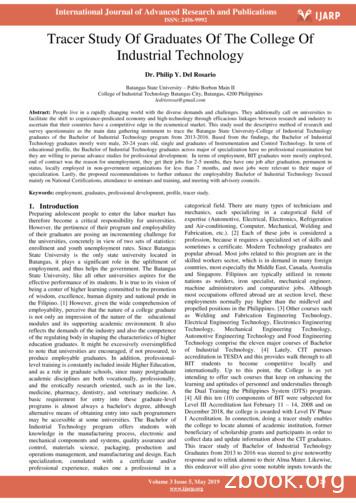SCIENCE ENGINEERING & TECHNOLOGY
JESSAMINE C O U N T Y 4 - H4-H PORCH PROJECTSSCIENCE ENGINEERING &TECHNOLOGYScience porch projects to go! We will have all of thefollowing items in ONE KIT! You may take ONE perchild. Please visit our FaceBook page to share yourcreations and let us know a little about you! Use#jessco4H when posting about your project!Thursday April 23, 2020 Pick upstarting at 1pm until gone!Inside each bag:****Make your own FLOAMMake your own Bouncy BallMake your own GEODEStraw Rockets!
WHAT IS FLOAM?Floam is a cross between play dough and slime.It's mold-able slime! How cool is that! Make your own byfollowing the recipe below.FLOAM RECIPE2 tsp of borax1/2 cup of warm water & 1/4 cup of warm water- divided2 oz of white school glue1 & 1/3 cups of polystyrene beads (bean bag filler)Optional: Food coloring or liquid watercolors if color isdesiredMETHODIn a bowl combine 2 teaspoons of borax with 1/2 cup of verywarm water.Mix until the borax is dissolved.In a separate bowl combine 1/4 cup of white school glue with 1/4cup of water. Add several drops of food coloring or liquid watercolors if color is desired.Once the ingredients of both bowls are mixed pour the glue mixture into a zip seal bag. Add the polystyrene beads, and then addthe borax and water mixture and seal the bag.Once sealed mix the ingredients in the bag well until the floam isformed.You can use more or less of the borax and water mixture to create different floam consistencies.Use more borax for a stiffer and more mold-able floam.Use less borax to create a more slime-like floam.Mixing the floam is really fun for kids and is an activity all in itself.Floam is so fun! It can be molded and shaped like play dough but isalso squishy and gooey like slime. It has a really unique texture thatis irresistible to touch.Floam can be stored in an air-tight container for endless play, or kidscan leave their creations out to dry and preserve their works of art.https://www.growingajeweledrose.com
To make beautiful geodesin your ownkitchen you need more patience and timethan anything else! Here isthe basic recipeto start you off in the world of beautiful geodes.Project recipe: 3 Tablespoons Borax– Included1 Cup boiling water, on handFood coloringPipe cleaners– IncludedLarge jar, glass or pitcher, on handDish cloth, on handPopsicle Stick—IncludedFishing line or curling ribbon, IncludedThe color of the pipe cleaner is what decides the color ofyour crystals. For example, I used dark blue to get thesapphire colour. If you only have white pipe cleaners,you can use food coloring in the water to dyethem. Metallic pipe cleaners work best.Shape the pipe cleaner(s) and thread fishing line or curlingribbon through the edge.\Put it in your empty container and using a skewer, butter knifeor chop stick, tie the ends around it so that your pipe cleanershape doesn’t touch the sides or bottom of your container. Once you’ve got it tied off at the right height, remove itfrom the container before you add your water.
Add your pipe cleaner shape tied to the skewer, butterknife or chop stick and cover with a dish cloth.Let sit overnight or about 5 hours.Uncover and be amazed!Carefully pull out the fishing line or curlingribbon from your finished geode.Notes:Don’t throw your water away! To reuse it, heat the water to boiling again and add 1 &1/2 tablespoons of Borax.I believe that what little affect the food coloring has will fade pretty quickly. Coveryour geodes with a coat of clear nail polish if you use food coloring.The longer your geode is immersed in the water, the bigger the crystals will be.I strongly suggest curling ribbon or fishing line to suspend your pipe cleaners. Ioriginally used string and couldn’t pull it out of my finished geode.For larger geodes, make a cage out of chicken wire and wrap it with pipe y-geodes/
HOW TO MAKE A SUPER BOUNCY BALLSUPER Bouncy BallsSo here it is! Our recipe for super bouncy balls using just THREE ingredients (and one of those is lls/Ingredients 1/2 Cup of Warm Water1 TBSP of Borax1 to 2 TBSP of Clear Elmer’s Glue (or Elmer’s Clear Glitter Glue)A couple of notes on these ingredients Borax is safe to use, IF used properly. This project is not suitable for children under 3 years old. Only use a very small amount and make sure you dissolve it fully before using. Burns or skin irritation might occur if it is use withoutdiluting it first. Do not use if you or your child have any sort of skin condition or sensitive skin (or wear gloves to mix it). Supervise children and make sure they don’t put their hands in their mouth after using it. And with all craft projects, make sure you wash your hands afterwards!Glitter Glue: After we used up our bottle of Elmer’s Glitter Glue, we still wanted to make more (addictive!) so we tried using the dollarstore glitter glue. Nope! It just didn’t work. There’s something about the Elmer’s glue that is different to the generic glues.How to Make Super Bouncy BallsStep 1: Making Borax Solution(It’s probably best for a grown up to do this step.)You want to stir together the 1/2 cup of warm water and 1 tablespoon of borax, until it is completely dissolved (add morewater if it doesn’t all dissolve).If the water is hot, allow it to cool.Step 2: Add Your GlueNext slowly pour your desired amount of glue into the bowl of borax solution. The more glue you use, the bigger the ball!(We used about 2 tablespoons of glue)To get this light blue translucent glitter super bouncy ball, we combined clear and glitter glue together as we poured itinto the borax solution.Step 3: Squish and Squeeze!As soon as the glue hits the borax solution it will start to harden. Gently squeeze and squish the glue ball until it is nolonger sticky.Remove from the borax solution and roll between your hands to make it ball shaped.Note: The glue is going to go hard, not the borax solution. You will be left with a bowl of solution, so you can repeat the process andmake as many super bouncy balls as you like!That’s it! How easy is that? And they really do BOUNCE!A word of warning. These super bouncy balls are basically very very thick slime. So if you leave them for any length of time they willslowly go flat and make a disc. But it’s very simple to just roll them in your hand to make them ball shaped again.
Life Skills:Teaches others coachesto apply related conceptsAerospace Skill:Building a straw rocketScience Skill:Building modelsWhat To Do:Make a drinking strawrocket.Materials: two 1" x 2 1/2" adhesive address labels,drinking straw—regular size, milk shake straw—slightly larger than a pencilNOTE: Drinking straw must fit just inside themilk shake strawRockets Away!As easy as 1, 2, 3 you can make your very ownrocket that goes as high as you can blow. Inthis activity you will make your own drinkingstraw rocket, discover rocket parts and theirpurpose, compare your rocket to a modelrocket and teach a friend the parts of amodel rocket. Building a straw rocketwill also help you prepare to builda model rocket kit.DrinkingStrawMilk ShakeStrawLabelLabelsBlast OffWork with a friend to makeyour rocket.1. First cut the labels in halfto make four 1" x 11/4" labels.2. Then wrap one labelaround the end of the largemilk shake straw; sealcompletely to form a nosecone shape.7. Experiment with your straw rocketby changing the fins. Use larger labels,different numbers of fins, or bend and twistthe fins. Estimate and record the length andheight of each flight in the chart.8. Check Hangar Talk for the definitionsof the parts, and write in the letter of eachpart on the illustration below.3. Attach both ends of eachof the remaining labels to thebottom of the straw that hasthe nose cone. Stick theadhesive together and creaseto make three fins.5. Now that you and yourfriend have made a rocket,teach another friend how tomake a similar rocket. Tryto teach in a way that letsyour "student" learn bydoing before being toldor shown how. 4. Put the drinking strawinside the large milk shakestraw. Countdown,“10.9.8.” Aim straightinto the air, blow and gentlyblast-off! Flight dMe/FriendCommentsWord BankA. Body TubeB. Nose ConeC. Engine HookD. FinsE. RecoverySystem (parachute)F. Launch LugG.Engine MountH. Shock CordI. Schroud Lines
DebriefingGround to Ground (Share) Explain how you made your rocket. Share with your helper how you taught your friend.Climb Out (Process) How is your straw rocket similar to the model rocket?How is it different? What happened each time you changed your fins? Sir Isaac Newton(1642–1727), anEnglish scientist,astronomer andmathematician,was the first to discover anddescribe some of the lawsof motion and gravity thattoday help us understand howthings move and how they fly.Newton's first law of motionsays any object that is stillwill stay still, and any objectthat is moving will staymoving, unless they are actedon by an unbalanced force.Level Off (Generalize)You can see Newton's firstlaw with your rocket. It will How do you feel about teaching others? About learningfly nowhere until you blowfrom others?into it. What do you like others to do when they are teachingyou something new?Your breath creates an"unbalanced force" andaway it goes! Cross Country (Apply) If you were going to teach a friend howto do something, how would you do it?Changing the finscan make a difference.1. Make an EstesWizard rocketavailable from 4-HSource Book. SeeProp Shop, page 36.2. Exhibit a rocket ata fair or other publicexhibition.7
rocket and teach a friend the parts of a model rocket. Building a straw rocket will also help you prepare to build a model rocket kit. 7. Experiment with your straw rocket by changing the fins. Use larger labels, different numbers of fins, or bend and twist the fins. Estimate and record the length and height of each flight in the chart. 6
Materials Science and Engineering, Mechanical Engineering, Production Engineering, Chemical Engineering, Textile Engineering, Nuclear Engineering, Electrical Engineering, Civil Engineering, other related Engineering discipline Energy Resources Engineering (ERE) The students’ academic background should be: Mechanical Power Engineering, Energy .
Replacing: ND: Engineering: Electrical Diploma in Engineering Technology in Electrical Engineering (Extended), Replacing: ND: Engineering: Electrical (Extended) Diploma in Engineering Technology in Computer Engineering, Replacing: ND: Engineering: Computer Systems Bachelor of Engineering Technology in Electrical Engineering *New Qualification*
OLE MISS ENGINEERING RECOMMENDED COURSE SCHEDULES Biomedical engineering Chemical engineering Civil engineering Computer engineering Computer science Electrical engineering General engineering Geological engineering Geology Mechanical engineering Visit engineering.olemiss.edu/advising for full course information.
as Welding and Fabrication Engineering Technology, Electrical Engineering Technology, Electronics Engineering Technology, Mechanical Engineering Technology, Automotive Engineering Technology and Food Engineering Technology comprise the eleven major courses of Bachelor of
The College of Engineering offers six Bachelor of Science in engineering programs – bioengineering, chemical engineering, civil engineering, computer science and engineering, electrical engineering and mechanical engineering. A seventh program, the Bachelor of Sciencein environmental engineering
ABET ,https://www.abet.org: biomedical engineering, chemical engineering, civil engineering, computer engineering, electrical engineering, environmental engineering, engineering management, mechanical engineering, and engineering. The computer science program is accredited by the Computing Accreditation Commission (CAC) of ABET,
Science Color & Light Delta Science Module (DSM) 4 Science Mixtures & Solutions Kit Full Option Science System (FOSS) 5 Science Landforms Kit Full Option Science System (FOSS) 5 Science Variables Kit Full Option Science System (FOSS) 5 Science Environments Full Option Science System (FOSS) 5 Science Oceans Delta Science Module (DSM) 5
Introduction to Science Section 2 The Branches of Science, continued The branches of science work together. -biological science: the science of living things botany, ecology -physical science: the science of matter and energy chemistry: the science of matter and its changes physics: the science of forces and energy -earth science: the science of the Earth, the























